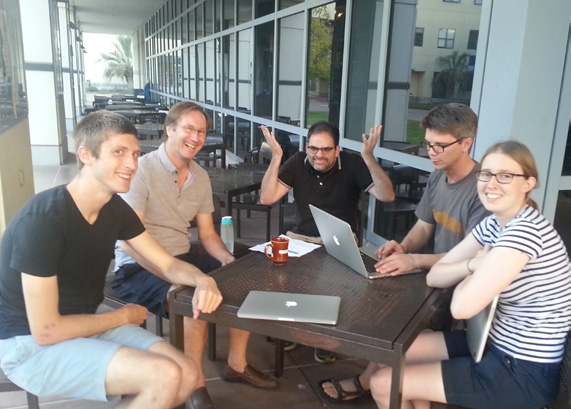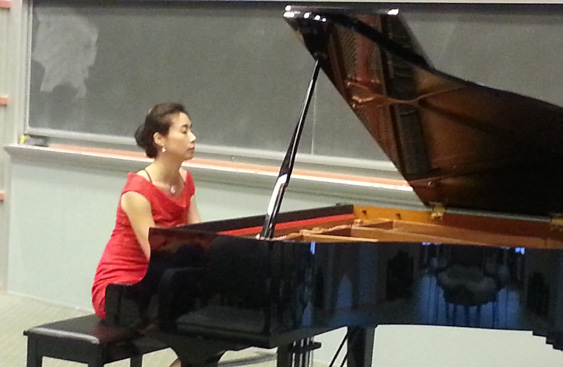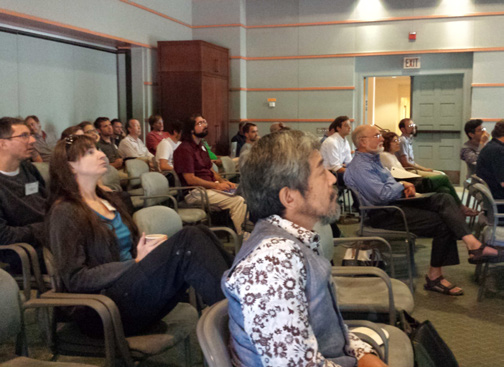 Nuclear Physicists happily disagreeing on hard problems! From left to right: M. Wagman (Institute of Nuclear theory), M. Savage (Institute of Nuclear theory), B. Tiburzi (CUNY), W. Detmold (MIT) and P. Shananahan (MIT). Photo by Z Davoudi.
Nuclear Physicists happily disagreeing on hard problems! From left to right: M. Wagman (Institute of Nuclear theory), M. Savage (Institute of Nuclear theory), B. Tiburzi (CUNY), W. Detmold (MIT) and P. Shananahan (MIT). Photo by Z Davoudi.
Nuclear physicists headed to the KITP in the fall of 2016 to participate in an exciting program on the “Frontiers in Nuclear Physics”, along with a conference on “Symmetry Tests in Nuclei and Atoms.” With new theoretical understandings, advances in technology and a vibrant experimental program, addressing some of the extremely challenging questions in nuclear physics is now a reality. Nuclear systems constitute the core of the ordinary matter in the universe, from stars and supernovae to chemical elements and living organisms. Furthermore, with a great interest in unraveling the mystery of neutrinos, dark matter and other new physics possibilities, progress in nuclear physics is crucial for the success of a large number of experimental programs. Nuclear physicists are moving in on being able to predict, with certainty, the Standard effects.
Protons and neutrons, collectively called nucleons, of which the nucleus of an atom is made of, are themselves formed by elementary particles called quarks and gluons. The quantum field theory that describes the quarks and gluons and their interactions is called quantum chromodynamics (QCD). At the heart of the complexity inherent in these entangled systems of nucleons is that QCD is nonperturbative at most relevant energy regimes. In other words, the interactions can be very strong and no expansion in a small interaction coupling can correctly obtain the properties of the system. It is a highly complex problem to construct even a single nucleon out of its QCD constituents. For instance, the important question of how the nucleon’s mass and spin emerge from a QCD description is yet to be fully understood, but rapid progress is being made using the numerical technique of lattice QCD. When a collection of protons and neutrons are considered, complexity of the problem is greatly increased, posing further difficulties to the theoretical calculations.
 Pianist, Prof. Young-Hyun Cho of the University of Texas Arlington, performing a solo piano recital featuring works by Chopin and Mussorgsky at Kohn Hall. Photo by Z Davoudi.
Pianist, Prof. Young-Hyun Cho of the University of Texas Arlington, performing a solo piano recital featuring works by Chopin and Mussorgsky at Kohn Hall. Photo by Z Davoudi.
Lattice QCD is the method of solving QCD by a probabilistic sampling of the quantum trajectories of the system. It offers the promise of, and has an established success in, showing how nucleons emerge from fundamental interactions. Computational resources are becoming significant as we head towards the exascale era, promising more precise calculations of complex systems in the near future. Large systems of nucleons, however, will likely not be amenable to direct lattice QCD methods. For example, a QCD description of the 76Ge isotope requires considering (naively) 10373 possibilities for quantum correlations in a complicated background of vacuum fluctuations! Germanium, through its potential neutrinoless double-beta decay mode, is a popular isotope in experiments that are searching for the violation of lepton number in nature, and can unravel the mystery of the neutrino mass. To make conclusive statements about the underlying new physics, phenomenological modelings must be superseded with a combination of first principles QCD calculations and nuclear many body techniques. However, with lattice QCD calculations of light nuclei presently at early stages, and calculations of more complex systems not imminent, what is the path forward? One way to proceed is to construct effective descriptions of few nucleon interactions, constrained by experiments or by solving the underlying theory, and utilize them in modern nuclear many body calculations formulated in terms of nucleons. Illuminating aspects of this critical path was at the core of intense and productive discussions at the KITP.
 Photo from archived program wikispaces.
Photo from archived program wikispaces.
The strength and novelty of this program was to bring together nuclear theorists that had focused on different steps of the ladder that starts from QCD and progresses towards many body descriptions of heavy nuclei. A focus of this meeting was to understand how to connect different levels of the ladder so that no uncontrolled errors due to the lack of knowledge of the underlying interactions at the bottom would plague quantities of great interest at the top. Exciting progress occurred in several topics, including the mysterious role of gluons in nuclear structure relevant for an Electron Ion Collider, the theory opportunities for the Facility for Rare Isotope Beams and its impact on our understanding of explosive astrophysical environments, the equation of state of neutron stars including its role in gravitational wave observations, the electric dipole moment of atoms and nuclei in the search for broken time reversal invariance in nature, the neutrinoless double-beta decay in nuclei and its link to new physics, and reaction theory for an intellectual investigation of the anthropic principle and practical applications for energy production facilities. This program marked the start of a new era in the continual pursuit of underpinning nuclear physics with the Standard Model, and opening the door to the explorations of physics beyond it.
Zohreh Davoudi is a postdoctoral research associate at the Center for Theoretical Physics at MIT and was in residence at the KITP for this program.
KITP Newsletter, Spring 2017
